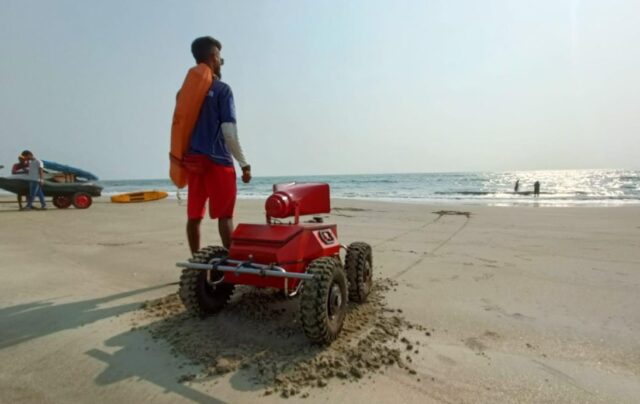In a first-of-its-kind innovation, Drishti Marine, Goa’s state-appointed lifeguard organisation, has introduced artificial intelligence (AI) in the form of Aurus, a self-driving robot and Triton, an AI-powered monitoring system, to augment its life-saving capabilities along Goa’s popular beaches and water bodies.
The incorporation of AI-based support follows an increase in beach-related incidents due the rising numbers in domestic and foreign tourists flocking to the coastline. The past two years have witnessed over 1,000 rescue incidents along the coastal belt, which have required assistance from Drishti Marine’s lifesavers.
Both the AI monitored camera-based systems can monitor the surroundings, assess and detect risks, share real-time information with on-duty lifeguards so they may respond faster to avoid tragic incidents.
Developed by Drishti Works, a division of Drishti, AURUS mans the state’s expansive coastal stretch. The new addition will aid in increased surveillance and crowd management of beaches. AURUS is a self-driving robot developed to assist lifesavers by patrolling extensive non-swim zones and alerting tourists during high tide. It employs artificial intelligence to assist lifeguards in a variety of beach duties. AURUS will work alongside lifesavers in emergency circumstances, from patrolling to providing multilingual notifications. Furthermore, the AI bot bears a 100-kilo payload and hence also doubles up as a logistics support vehicle. Aurus has completed 110 hours of autonomous work along the coast, covering approximately 130 kilometres.
Along with the AURUS, the TRITON AI system’s primary focus is to provide completely AI-based monitoring of non-swim zones, thereby, alerting tourists of the danger and notifying the nearest lifesaver. It will work in tandem with AURUS to provide comprehensive coverage of the beaches. TRITON will patrol non-swim zones, identify and transfer information to lifesavers and help them identify tourists entering the water during high tide and in danger-prone areas.
“The main reason is to incorporate new technology under the banner of lifesaving to help to mitigate risks while assisting the manpower to be more effective in ensuring the safety and security of individuals on the beaches. The inclusion of AI highlights the progress made in the department of lifesaving. As society grows more and more reliant on technology, it’s only suitable to ensure it is appropriately applied in all sectors of life,” says Navin Awasthi, Operations Head of Drishti Marine. TRITON has so far completed 19,000 hours of runtime.
AURUS and TRITON are operated by ‘tech lifesavers’ who are located in the central control room. The team decides the areas that AURUS and TRITON will patrol. On-site lifesavers are given the training required to operate basic aspects of the two technologies. AURUS is currently deployed at Miramar Beach in North Goa for assistance in beach closure, while TRITON is deployed at Baina, Velsao, Benaulim, Galgibag in South Goa and Morjim in North Goa.
“Both AURUS and Triton are largely support systems. The device has the potential to save lives, especially during peak season when lifeguards must monitor and patrol wide portions of the beach that are swamped with visitors. The two AI-based systems have increased team efficiency and enabled wider coverage. We hope that as the systems improve, they will become an essential part of every beach, making our beaches the best protected in the world.”, Navin Awasthi also said
Drishti intends to deploy 100 Triton units and 10 AURUS units on the beaches of Goa this year..



















